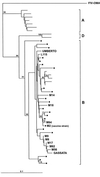Immunogenicity of an anti-clade B feline immunodeficiency fixed-cell virus vaccine in field cats
- PMID: 11069985
- PMCID: PMC113170
- DOI: 10.1128/jvi.74.23.10911-10919.2000
Immunogenicity of an anti-clade B feline immunodeficiency fixed-cell virus vaccine in field cats
Abstract
Attempts at vaccine development for feline immunodeficiency virus (FIV) have been extensive, both because this is a significant health problem for cats and because FIV may be a useful vaccine model for human immunodeficiency virus. To date, only modest success, producing only short-term protection, has been achieved for vaccine trials in controlled laboratory settings. It is unclear how relevant such experiments are to prevention of natural infection. The current study used a vaccine that employs cell-associated FIV-M2 strain fixed with paraformaldehyde. Subject cats were in a private shelter where FIV was endemic, a prevalence of 29 to 58% over an 8-year observation period. Cats roamed freely from the shelter through the surrounding countryside but returned for food and shelter. After ensuring that cats were FIV negative, they were immunized using six doses of vaccine over a 16-month period and observed for 28 months after the initiation of immunization. Twenty-six cats (12 immunized and 14 nonimmunized controls) were monitored for a minimum of 22 months. Immunized cats did not experience significant adverse effects from immunization and developed both antibodies and cellular immunity to FIV, although individual responses varied greatly. At the conclusion of the study, 0 of 12 immunized cats had evidence of FIV infection, while 5 of 14 control cats were infected. Thus, the vaccine was safe and immunogenic and did not transmit infection. Furthermore, vaccinated cats did not develop FIV infection in a limited clinical trial over an extended time period. Thus, the data suggest that a fixed, FIV-infected cell vaccine has potential for preventing natural FIV infection in free-roaming cats.
Figures





Similar articles
-
Immunization-induced decrease of the CD4+:CD8+ ratio in cats experimentally infected with feline immunodeficiency virus.Vet Immunol Immunopathol. 1992 Dec;35(1-2):199-214. doi: 10.1016/0165-2427(92)90132-a. Vet Immunol Immunopathol. 1992. PMID: 1363009
-
Efficacy evaluation of prime-boost protocol: canarypoxvirus-based feline immunodeficiency virus (FIV) vaccine and inactivated FIV-infected cell vaccine against heterologous FIV challenge in cats.AIDS. 1998 Jan 1;12(1):11-8. doi: 10.1097/00002030-199801000-00002. AIDS. 1998. PMID: 9456250
-
Recombinant FeLV vaccine: long-term protection and effect on course and outcome of FIV infection.Vet Immunol Immunopathol. 1995 May;46(1-2):127-37. doi: 10.1016/0165-2427(94)07012-v. Vet Immunol Immunopathol. 1995. PMID: 7618252 Free PMC article.
-
Efficacy and safety of a feline immunodeficiency virus vaccine.Anim Health Res Rev. 2004 Dec;5(2):295-300. doi: 10.1079/ahr200487. Anim Health Res Rev. 2004. PMID: 15984343 Review.
-
Diagnosing feline immunodeficiency virus (FIV) and feline leukaemia virus (FeLV) infection: an update for clinicians.Aust Vet J. 2019 Mar;97(3):47-55. doi: 10.1111/avj.12781. Aust Vet J. 2019. PMID: 30809813 Review.
Cited by
-
Env-expressing autologous T lymphocytes induce neutralizing antibody and afford marked protection against feline immunodeficiency virus.J Virol. 2010 Apr;84(8):3845-56. doi: 10.1128/JVI.02638-09. Epub 2010 Feb 3. J Virol. 2010. PMID: 20130057 Free PMC article.
-
Evaluation of feline monocyte-derived dendritic cells loaded with internally inactivated virus as a vaccine against feline immunodeficiency virus.Clin Vaccine Immunol. 2008 Mar;15(3):452-9. doi: 10.1128/CVI.00421-07. Epub 2008 Jan 23. Clin Vaccine Immunol. 2008. PMID: 18216184 Free PMC article.
-
The Comparative Value of Feline Virology Research: Can Findings from the Feline Lentiviral Vaccine Be Translated to Humans?Vet Sci. 2017 Jan 28;4(1):7. doi: 10.3390/vetsci4010007. Vet Sci. 2017. PMID: 29056666 Free PMC article. Review.
-
Evolution of replication efficiency following infection with a molecularly cloned feline immunodeficiency virus of low virulence.J Virol. 2002 Jun;76(12):6062-72. doi: 10.1128/jvi.76.12.6062-6072.2002. J Virol. 2002. PMID: 12021339 Free PMC article.
-
Feline immunodeficiency virus model for designing HIV/AIDS vaccines.Curr HIV Res. 2010 Jan;8(1):14-25. doi: 10.2174/157016210790416361. Curr HIV Res. 2010. PMID: 20210778 Free PMC article. Review.
References
-
- Almond N M, Heeney J C. AIDS vaccine development in primate models. AIDS. 1998;12:S133–S144. - PubMed
-
- Bishop S A, Stokes C R, Gruffydd-Jones T J, Whiting C V, Humphries J E, Osborne R, Papanastasopoulou M, Harbour D A. Vaccination with fixed feline immunodeficiency virus (FIV) infected cells: protection, breakthrough and specificity of response. Vaccine. 1996;14:1243–1250. - PubMed
Publication types
MeSH terms
Substances
LinkOut - more resources
Full Text Sources
Miscellaneous

